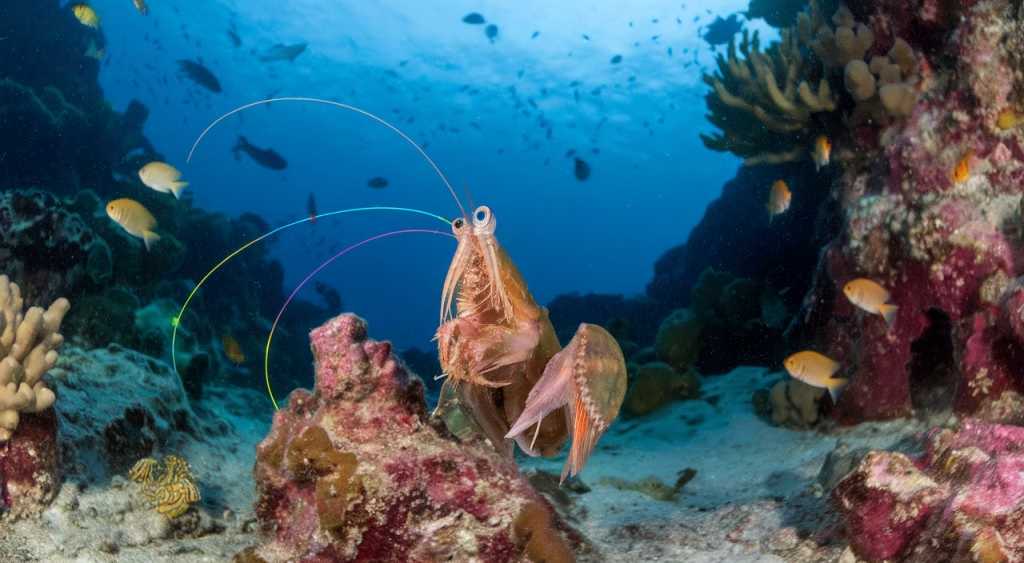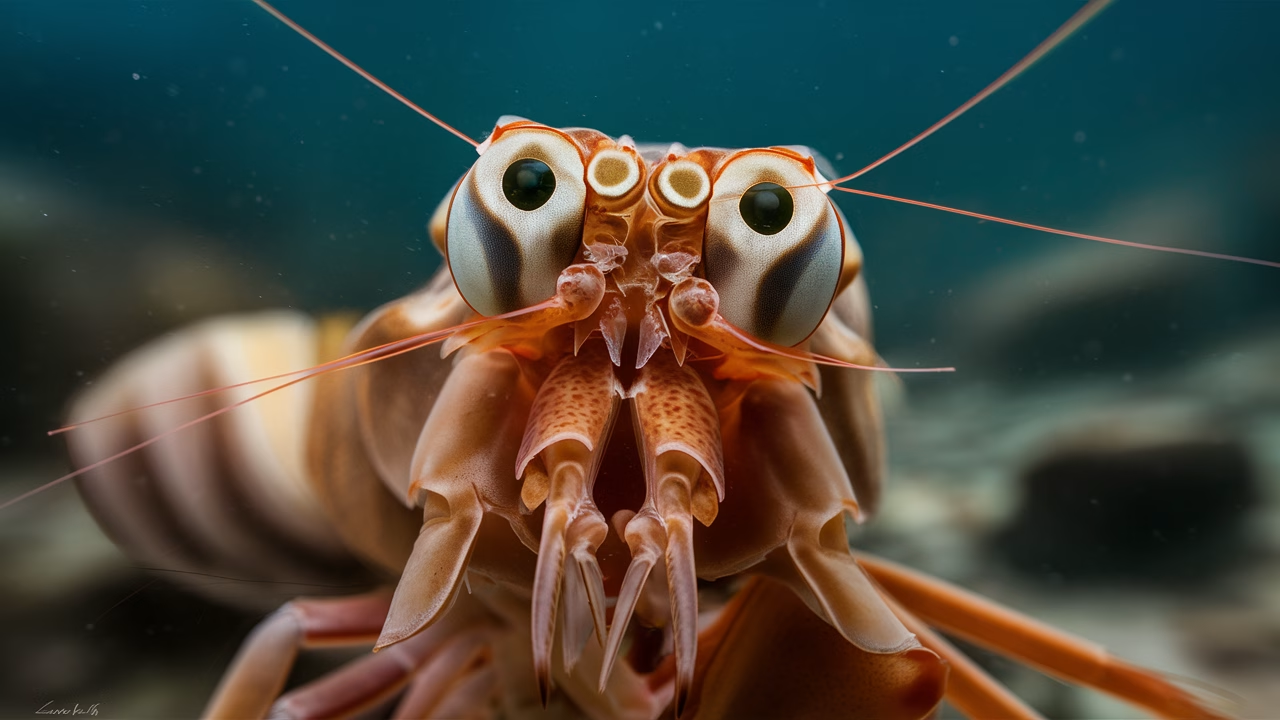How do mantis shrimp detect polarized light in their environment?
Mantis shrimp detect polarized light through specialized photoreceptor cells and intricate signaling mechanisms in their compound eyes. These marine animals possess the extraordinary ability to perceive different types of polarized light—including the rare capability to detect circularly polarized light. This polarized light detection allows them to navigate, hunt, and communicate in underwater environments that humans can’t even perceive without specialized equipment.
TL;DR: Mantis Shrimp’s Polarized Light Superpowers
- Extraordinary Eyes: Mantis shrimp possess up to 16 types of photoreceptor cells compared to our mere three.
- Polarization Power: They can detect both linear and circularly polarized light—a skill unmatched in the animal kingdom.
- Functional Vision: This ability enhances communication, hunting accuracy, and predator avoidance in turbid marine environments.
- Marine Optics Breakthrough: Their visual system is inspiring optical technology in underwater navigation and biomedical imaging.
- Beyond the Shrimp: Understanding their vision opens new insights into vision evolution across marine species.
Introduction: The Intriguing World of Mantis Shrimp
Ever looked into the turbulent blues and greens of the ocean and wondered how marine animals interpret that water-filtered kaleidoscope of light? Let’s zero in on one of the most visually advanced marine animals on Earth—the mantis shrimp. What if we told you that this riotously colorful little predator doesn’t just see the rainbow; it perceives divisions in polarized light that you and I cannot detect?
From a marine optics perspective, this creature is not just interesting—it’s revolutionary. Its visual system pushes the boundary of what biology can achieve when it comes to polarized light detection. But more than that, it gives us a blueprint for innovation ranging from biomedical imaging to underwater navigation. In this article, we’ll dive deep—pun intended—into how mantis shrimp detect polarized light, and why it matters in science and technology today.
How Mantis Shrimp Detect Polarized Light
It’s not exaggeration to say that mantis shrimp possess one of the most biologically complex visual systems known to science. These marine animals have compound eyes perched on stalks, each subdivided into three regions—meaning they literally perceive the world with trinocular and stereoscopic vision in each eye. But what makes their vision superlative is their ability to detect polarized light underwater.
Mechanisms Behind Polarized Light Detection
In simple terms, polarized light occurs when light waves oscillate in a single plane. Most marine animals cannot perceive this. Some, like certain insects or cephalopods, can detect linear polarization—helpful for navigation or prey spotting. However, mantis shrimp can see linear and circularly polarized light, a property that is especially rare in nature and crucial for marine optics.
| Type of Polarized Light | Can Mantis Shrimp Detect It? | Application in Nature |
|---|---|---|
| Linear Polarized Light | Yes | Navigation and camouflage detection |
| Circularly Polarized Light | Yes | Communication and species recognition |
| Unpolarized Light | Yes | General vision |
This capacity stems from their unique midband rows, particularly rows 5 and 6, which house cells specialized for distinguishing the angular orientation of polarized light. Additionally, their photoreceptors are organized with chiral properties, allowing them to interpret circularly polarized light—which even our best instruments struggle to do without filters and tuning.
Real-World Insight
Here’s what often amazes researchers: Underwater, where colors fade and light scatters, the ability to detect polarized light can dramatically enhance contrast and visibility. It’s not just an evolutionary party trick—it’s how these marine animals find mates, pick off camouflaged prey, and dodge predators. No specialized equipment required.
Evolutionary Advantages of Polarized Light Detection
So, why would a shrimp evolve such an advanced visual toolkit for detecting polarized light? Evolution rarely produces complexity without function, especially in marine environments where visual clarity is crucial.
- Communication: Mantis shrimp use patches on their exoskeleton that reflect circularly polarized light—a signal visible only to those with the right eyes to see it. Communication becomes more secure and specific, even in crowded reefs.
- Prey Detection: Many marine animals have shiny, polarized skins. This means hidden squid or shrimp, invisible to most eyes, practically light up under polarized vision.
- Mating and Territory: Recognition of subtle polarized markings can distinguish individuals or species, potentially playing a role in mating behavior among marine animals.
In environments where visibility is often compromised by turbidity or low light, anything that enhances visual filtering becomes an evolutionary edge. Through this lens, understanding how mantis shrimp detect polarized light in deeper waters helps unravel broader survival strategies among marine animals.
Practical Applications in Marine Optics
Here’s where things get exciting for marine optics research. The exotic elegance of mantis shrimp vision isn’t just a scientific curiosity—it’s being studied to inform cutting-edge technologies. Using models of circularly polarized light detection found in mantis shrimp eyes, engineers are pioneering devices that offer improved contrast imaging and augmented vision under the sea.
- Underwater Navigation: Autonomous underwater vehicles (AUVs) are testing mantis shrimp-inspired polarization sensors to better navigate in murky marine environments.
- Medical Imaging: Circularly polarized light can distinguish between types of tissues or detect cancerous growths early on, inspired by how these marine animals process visual information.
- Information Security: Visualization systems based on polarization can transmit signals readable only by equally tuned receivers—allowing for secure marine species-specific communication concepts.
Humans have built sonar and radar to conquer the oceans, but emulating the mantis shrimp’s natural polarized light detection could revolutionize how we perceive underwater terrains and even body tissues.
Implications for Other Species in the Ocean
Mantis shrimp aren’t the only marine species that interact with polarized light—though they do lead the pack in detection capabilities. Polarization sensitivity has independently evolved in cephalopods like cuttlefish, various fish species, and even some crustaceans. But the shrimp’s complex system provides a model by which we can understand broader evolutionary trends in marine animals’ vision.
- Polarized light in nature may serve as a hidden visual channel in marine ecological niches.
- Species reliant on camouflage may evolve counter-features to disrupt polarized signals among marine animals.
- Studying how mantis shrimp detect polarized light may uncover how environmental pressures shape sensory development more broadly.
Consider this: If we better understand the mechanisms behind how mantis shrimp detect polarized light, we also gain insights into how other marine animals may similarly interpret their watery world—even if our eyes aren’t built to see it.
Final Thoughts: Seeing the Ocean through Mantis Shrimp Eyes
By now, it’s clear—when we study how mantis shrimp detect polarized light, we’re just scratching the surface of marine optics. We’re uncovering a world built on invisible wavelengths and decoding a silent language beneath the waves. These marine marvels challenge us to reinvent not just how we look at the natural world, but also how we build tools to perceive it more fully.
In practice, the implications of polarized light detection stretch from academic fascination to practical innovation in marine optics and bioengineering. Understanding the mantis shrimp’s eye is to glimpse evolution at its most efficient and artful. So, next time you think you see the ocean clearly, remember: you’re only seeing a fraction of what these remarkable marine animals can perceive.
Frequently Asked Questions
- Can mantis shrimp see polarized light?
Yes. Mantis shrimp can detect both linear and circularly polarized light, a rare ability among animals. - What type of eyes do mantis shrimp have?
They have compound eyes with trinocular and stereoscopic capabilities in each eye, divided into three distinct regions. - How do mantis shrimp use polarized light for hunting?
They use polarization to detect prey by enhancing contrast in turbid or low-light environments, revealing camouflaged creatures. - Why is their ability important in marine optics?
Their vision inspires technology for imaging in visually challenging environments, like turbid water or internal tissues. - Do any other species see polarized light?
Yes. Some cephalopods, insects, and fish exhibit limited forms of polarization vision, though not to the mantis shrimp’s extent. - Can humans perceive polarized light?
Not naturally, though we can detect its effects indirectly, like through polarized sunglasses or special filters. - What are the uses of polarized light detection in marine animals?
These include navigation, communication, and predator/prey detection through contrast and hidden signals.





